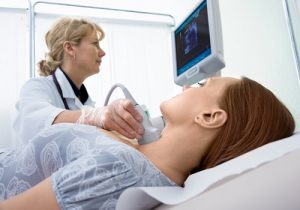
Thyroid ultrasound
Thyroid disease is a common endocrine disorder, especially in young children and pregnant women. A deficiency or excess of thyroid hormones causes serious health problems. The detection of thyroid disease is no longer difficult as the thyroid ultrasound technique is increasingly popular. So what are the benefits and risks of thyroid ultrasound?
1. What is thyroid ultrasound?
Thyroid ultrasound is a method of image diagnosis using sound waves, which the doctor will detect abnormalities in the thyroid.
The thyroid gland is located in front of the neck just above the neck bone, shaped like a butterfly, with a lobe on either side of the neck connected by a narrow strip of tissue. It is one of nine endocrine glands located throughout the body that produce and release hormones into the bloodstream.
During an ultrasound, the patient is asked to lie on their back or tilt their head to the sides. After that, the doctor applied a gel to the neck area that needed an ultrasound. The gel will keep the transducer safely in contact with the body and remove air pockets between the transducer and the skin that can block sound waves. The probe is placed on the skin of the neck and moves back and forth in the area to be examined.

2. The warning signs you need thyroid ultrasound
Localized pathologies rarely cause thyroid dysfunction, no systemic symptoms. Therefore, patients should have regular health checks even when there are no symptoms to detect lesions early. Besides thyroid disease there are some symptoms such as:
- Stress and shivering hands with arousal: these symptoms signal an increase in thyroid function.
- Attention disorders and poor concentration: hyperthyroidism (increased levels of thyroid hormones) and hypothyroidism (decreased levels of thyroid hormones) may affect nerve function. In hypothyroidism, you often feel sad and depressed. On the other hand, hyperthyroidism can lead to poor concentration.
- Menstrual changes: hypothyroidism is sometimes associated with menorrhagia and amenorrhea, while hyperthyroidism is characterized by amenorrhea.
- Edema, fluid retention: this is a sign of hypothyroidism.
- Increased heart rate: tachycardia and palpitations may be symptoms of hyperthyroidism.
- Pain: myalgia is associated with thyroid problems.
- Weight gain: the condition is often accompanied by lower than normal thyroid function.
- High cholesterol levels: An increase in blood cholesterol levels may occur in people with hypothyroidism.
- Inability to tolerate heat: People with overactive thyroid usually cannot tolerate high temperatures.
- Poor cold tolerance: people with inactive thyroids feel cold often.
3. What is the purpose of thyroid ultrasound?
Thyroid ultrasound is often used for:
- Check for thyroid size, thyroid lesions (diffuse or localized lesions).
- Analyze the appearance of thyroid nodules, determine whether they are benign nodules or need a biopsy.
- Look for other neck lesions related to thyroid lesions such as lymph nodes.
- Monitor the progression of thyroid disease.
4. Procedure of performing an ultrasound of the thyroid gland
4.1 Preparation before thyroid ultrasound
With conventional echocardiography, you do not need to prepare anything to eat, drink and take medicine as usual. You should wear comfortable, spacious clothes.
Because ultrasound is very sensitive to motion, in children who cry and are hyperactive, it can take longer than usual. Parents can explain to children about the need for ultrasound or to bring books and toys to attract their attention and facilitate ultrasound support.
4.2 The procedure for ultrasound of the thyroid gland
Most ultrasound procedures take less than an hour, and the procedure may take longer or be shorter depending on your condition.
Your doctor will need to reduce the light in the ultrasound room to help you see the image more clearly, then you will be applied a special gel to increase the ability to transmit ultrasound.
4.3 What does the thyroid ultrasound need to do?
After the scan, if the doctor finds out the disease you will be consulted enthusiastically about the next steps to take, if there is no problem, you will be allowed to join the doctor. Every days.
5. Where is the ultrasound of the thyroid gland in Ho Chi Minh City? Ho Chi Minh
36 Ultrasound Clinic is one of the prestigious ultrasound addresses in Ho Chi Minh City. HCM. Since its establishment until now, Clinic has always strived in all medical activities to improve the quality of image diagnosis, healthcare for patients, with strengths such as:
5.1 Clinic equipment:
All modern machinery and equipment are 100% new invested and imported from G7 countries with modern and accurate technology.
5.2 Team of good, experienced doctors:
Being diagnosed by leading experts, experienced professors and doctors, regularly updating knowledge, advanced healthcare methods and modern medical techniques
5.3 Public and transparent costs:
All expenses at 36 Ultrasound Clinic are always publicly and transparently posted, suitable for all patients.
If you have any questions, please contact our 36 Ultrasound Clinic hotline: 0917717498; email: phongkhamsieuam36@gmail.com or directly to the clinic at 36 Street 6, Khang An Resident Area, Phu Huu Ward, Thu Duc City, HCM City.





